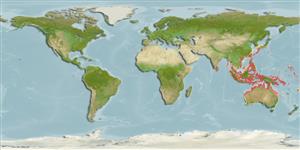>
Ovalentaria/misc (Various families in series Ovalentaria) >
Pseudochromidae (Dottybacks) > Pseudochrominae
Etymology: Labracinus: Greek, labrax, -akos = a fish, Dicentrarchus labrax (Ref. 45335); cyclophthalmus: Name from Greek 'kyklos' meaning circle and 'ophthalmos' for eye, referring to the dark curved marking around the midposterior rim of the orbit..
More on authors: Müller & Troschel.
Environment: milieu / climate zone / depth range / distribution range
Ecologie
marien rifbewoner; diepte 2 - 20 m (Ref. 9710), usually 10 - 15 m (Ref. 27115). Tropical; 22°C - 26°C (Ref. 27115)
Western Pacific: widely distributed throughout the Indo-Malayan Archipelago, from southern Japan, south to the Northwest Shelf of Australia, and east to New Ireland, Papua New Guinea.
Grootte / Gewicht / Leeftijd
Maturity: Lm ? range ? - ? cm
Max length : 23.5 cm TL mannelijk / geslacht onbekend; (Ref. 90102)
Dorsale stekels (totaal): 2; Dorsale zachte stralen (totaal): 24-26; Anale stekels 3; Anale zachte stralen: 14 - 15. Lower lip uninterrupted at symphysis. Vomerine teeth relatively large, arranged in a chevron. Caudal fin rounded; upper part with 5 - 6 procurrent rays and 9 principal rays. Lateral line with anterodorsal series of 43 - 62 (usually 48 - 62) tubed scales extending from gill opening, and a peduncular series of 12 - 14 (usually 18 - 22) tubed scales. Dorsal and anal fins with distinct scaly sheaths (Ref. 37748).
Found near shelter of coral or rock of shallow reefs (Ref. 9710), with moderate surge or currents, in spread-out groups of mixed sexes. Also in tidal pools, reef flats and reef slopes, often in relatively silty areas at depths ranging to 20 m (Ref. 81967). Moves about activity through the gutters and passages (Ref. 48635). Feeds on small fishes (Ref. 559). Frequently seen in the aquarium fish trade, and has been bred in captivity (Ref. 35416, 37748).
Levenscyclus en paargedrag
Maturiteit | Voortplanting | Paaien | Eieren | Fecunditeit | Larven
Kailola, P.J., 1987. The fishes of Papua New Guinea: a revised and annotated checklist. Vol. II Scorpaenidae to Callionymidae. Research Bulletin No. 41, Research Section, Dept. of Fisheries and Marine Resources, Papua New Guinea. (Ref. 6192)
Status op de Rode Lijst van het IUCN (Ref. 130435)
Gevaar voor de mens
Harmless
Gebruik door de mens
Aquarium: Commercieel
Meer informatie
Lokale namenSynoniemenMetabolismePredatorenEcotoxicologieVoortplantingMaturiteitPaaienPaaiaggregatiesFecunditeitEierenOntwikkeling van de eieren
ReferentiesAquacultuurAquacultuurprofielKweeklijnenGeneticaElectrophoresesErfelijkheidZiektesVerwerkingNutrientsMassaconversie
Tools
Speciale rapporten
Download XML
Internetbronnen
Estimates based on models
Preferred temperature (Ref.
123201): 26 - 29.3, mean 28.7 °C (based on 1882 cells).
Fylogenetische diversiteitsindex (Ref.
82804): PD
50 = 0.6250 [Uniqueness, from 0.5 = low to 2.0 = high].
Bayesian length-weight: a=0.01995 (0.00906 - 0.04395), b=3.01 (2.83 - 3.19), in cm total length, based on all LWR estimates for this body shape (Ref.
93245).
Trofisch niveau (Ref.
69278): 3.9 ±0.4 se; based on diet studies.
Weerstandsvermogen (Ref.
120179): Gemiddeld, minimale populatieverdubbelingstijd 1,4-4,4 jaar (Preliminary K or Fecundity.).
Fishing Vulnerability (Ref.
59153): Low vulnerability (14 of 100).
Nutrients (Ref.
124155): Calcium = 65.3 [32.3, 100.0] mg/100g; Iron = 0.654 [0.379, 1.062] mg/100g; Protein = 18.6 [17.5, 19.8] %; Omega3 = 0.109 [0.065, 0.178] g/100g; Selenium = 23.1 [12.3, 45.1] μg/100g; VitaminA = 126 [38, 396] μg/100g; Zinc = 1.04 [0.69, 1.51] mg/100g (wet weight);
